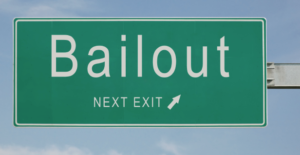22 Jan 2014 Yes, The ObamaCare ‘Risk Corridors’ Are An Insurance Company Bailout
Jonathan Cohn at The New Republic takes issue with conservatives who dub the ObamaCare “risk corridors” a “bailout.” (If you are unfamiliar with a “risk corridor,” see a full explanation at the end of the post. For now, it is taxpayer money that will go to insurance companies that sustain losses on the ObamaCare exchanges.)
Cohn claims:
 The bailout analogy is potent. And it’s certainly accurate to say that, under ObamaCare, some insurers may collect payments from the government to help offset losses. But the analogy breaks down after that.
The bailout analogy is potent. And it’s certainly accurate to say that, under ObamaCare, some insurers may collect payments from the government to help offset losses. But the analogy breaks down after that.
Bailouts typically start with companies taking egregiously irresponsible actions and end with the government forking over mind-boggling sums of money to save them. Think of the savings and loans institutions misleading the public about the state of their finances in the 1980s—or the financial industry making those bad home loans and risky investments a decade ago. Each of those involved grievous management errors, frequently skirting the limits of legality. The federal outlays to save those banks were in the hundreds of billions of dollars.
As Cohn explains how the risk corridors are different, he inadvertently shows that the insurers have engaged in egregiously irresponsible actions:
With Obamacare, the situation is different. Projecting future insurance costs inevitably involves a little guesswork. With a brand new program like Obamacare, it inevitably involves a lot of guesswork. Even the smartest, most responsible actuaries might not get the numbers right, for reasons Sy Mukherjee of ThinkProgress explains:
Insurance companies were sort of shooting in the dark when they set premiums for Obamacare’s first year. They had to approximate how many people would enroll, how old the customers would be, how sick they would be, how much insurers would have to pay out in claims — but the whole enterprise was, ultimately, a series of educated guesses.
Let’s see here: “involves a lot of guesswork,” “sort of shooting in the dark”—aren’t those other ways of saying that the actions that you are taking are very risky and you could incur substantial losses if things go sideways? Generally, although not always, the term for such behavior is “irresponsible.”
However, the term fits, but not because the insurers are taking gigantic risk without knowing the outcome. Indeed, they are taking the risk despite knowing the likely outcome. Insurers already had ample evidence what regulations like community rating and guaranteed issue that govern the Obamacare exchanges would do to an insurance market and the companies in those markets. The eight states that ruined their insurance markets with community rating and guaranteed issue in the 1990s—Kentucky, Maine, Massachusetts, New Hampshire, New Jersey, New York, Vermont and Washington—gave insurers plenty of evidence to ponder. In short, the young and healthy dropped out of the insurance market, premiums skyrocketed, and most insurers couldn’t make money and ended up leaving those states. Despite that, insurers still decided to take a mammoth risk and jump into the ObamaCare exchanges. It’s hard to imagine they would behave so irresponsibly—unless the federal government was going to bail out their losses.
I suspect what has Cohn and other ObamaCare supporters concerned is that opponents have found another very potent weapon. After all, who wants to defend an “insurance company bailout”?
RISK CORRIDOR: ObamaCare’s risk corridors are a temporary program that is supposed to help insurers mitigate the enormous amount of risk inherent in the ObamaCare exchanges. Under this program, an insurer in the exchange whose costs amount to 97% or less of its premiums must contribute part of its profits to reimburse insurers whose costs are 103% or greater of their premiums. Insurers who are profitable contribute only a portion of their profits while insurers who are not profitable see only portion of their losses reimbursed. See the scale below from this very informative article by Milliman. The problem occurs if there are not enough insurers who are “winners” to help fund the “losers.” If there are many more losers than winners, the federal government the taxpayers step in and pay the costs of the losers. And that is a very real problem given that not enough young people are signing up for insurance on the exchanges.



